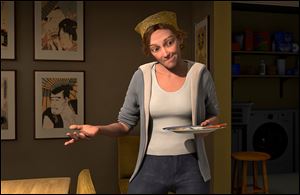
Near-realistic animation makes people squirm
4/6/2011
The character Milo's Mom, voiced by Joan Cusack, is shown in a scene from 'Mars Needs Moms.'
LOS ANGELES — Computer animation has a problem: When it’s too realistic, it starts creeping people out.
Most recently, moviegoers complained about the near-realistic depiction of humans in Disney’s 3-D flick Mars Needs Moms.
A theory called the “uncanny valley” says we tend to feel attracted to inanimate objects with human traits, the way a teddy bear seems cute. Our affection grows as an object looks more human. But if it looks too human, we suddenly become repulsed.
Instead of seeing what’s similar, we notice the flaws — and the motionless eyes or awkward movements suddenly make us uncomfortable.
Mars may have plunged to the bottom of this valley of fear.
“People always comment on things feeling strangely dead around the eyes,” said Chuck Sheetz, an animation director of The Simpsons and a professor at the University of California, Los Angeles. “If it gets too literal, it starts to feel false or has a strange effect.”
The near-realistic animation style championed by producer Robert Zemeckis uses motion-capture technology, where actors are covered with dots and skin suits and have their performances captured on computer. The dots provide the frame, and the rest is filled in with computerized graphics.
Mars creates humans that are more realistic and detailed than Zemeckis’ earlier attempts in such movies as Beowulf and The Polar Express — which were also criticized for inviting this discomfort.
Animation experts say the key to success is to be only authentic enough to tug at our heart strings.
The best example of this was Avatar, the 2009 blockbuster that made $2.8 billion in theaters worldwide. The humanoid, but blue-bodied Na’vi were alien enough not to trigger our inner rejection mechanism.
“My own personal opinion is try to stay away from photo-real with a human,” said Greg Philyaw, the business development director at Giant Studios, which captured the performance of human actors for their digital re-creation in Avatar. “Subconsciously you know what you’re looking at isn’t quite right.”
Mars had an estimated $150 million production budget, but has brought in just $34 million globally since its March 11 opening. To be fair, there were other problems besides being visually unnerving.
For one, it appeared to be marketed at young boys who are interested in science fiction but also are closely attached to their mothers. That is a small group to begin with and neglects dads and daughters.
Mars also came just a week after Paramount’s 2-D animated movie, Rango, starring Johnny Depp. Instead of appealing to fans because of the increasingly popular 3-D format, Mars may have annoyed theatergoers faced with higher 3-D ticket prices.
“If a movie’s unappealing and you’re trying to charge a higher ticket price for it, it makes it even less appealing,” said Brandon Gray, president of tracking company Box Office Mojo. He noted that Mars had the lowest opening weekend for a wide-release 3-D movie ever.